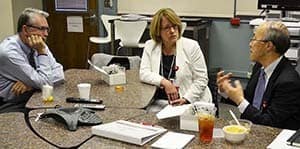UAMS Telemedicine Makes ‘Good Waves’ in Japan
May 20, 2013 | One year after UAMS donated telemedicine equipment to help a tsunami-devastated region of Japan, the positive outcomes of that gift are multiplying, prompting a Japanese physician to travel to Little Rock to thank the university in person.
“I wanted to come here as soon as possible, but it was a tough time for two years after the tsunami,” Nobukazu Nakasato, M.D., Ph.D., neurosurgeon and professor in the Department of Epileptology at Tohoku University School of Medicine in Sendai, Japan. “I wanted to come here to say ‘thank you very much’ for the donation of the equipment and for giving us the hint of what telemedicine can do.”
Through a sizeable grant from Polycom, a global leader in secure, easy-to-use video collaboration, the UAMS Center for Distance Health was able to give two, state-of-the-art units to Tohoku University Hospital and to Kensennuma City Hospital, along the Sendai coastal area of Japan, still struggling to recover from the 2011 tsunami.
Curtis Lowery, M.D., director of the UAMS Center for Distance Health, first met Nakasato at a medical conference in 1998 in Japan. After the tsunami, Lowery contacted him to see what UAMS and the center could do to better connect Nakasato to his epilepsy patients in areas of the Sendai region that had become even harder to reach because of the damage from the tsunami.
Nakasato was skeptical at first and viewed telemedicine as something akin to a robust version of Skype.
His first use of the technology and the donated equipment was in patient consultations and taking case histories.
“History taking is the number one, two and three thing in epilepsy care,” Nakasato said. “You have to have that face-to-face communication and with the high-definition video connection I don’t see any real difference between the real clinic and the telemedicine-based clinic.”
He also started envisioning other areas in which telemedicine could be useful, such as weekly case conferences and professional education.
Nakasato quickly became a vocal proponent of it, urging colleagues to try it just once. The reactions universally were positive.
Several institutions and areas in southern Japan have expressed a serious interest in using telemedicine in that part of the country to be ready and prepared for catastrophes like the tsunami that not only wreak destruction but overwhelm health care institutions with the injured left in their aftermath.
What Nakasato would like to see next in Japan for telemedicine is a three-fold expansion. The first is in the type of its use — an expansion into more case conferences between health care providers, lectures to local hospitals and professional collaboration. The second would be an expansion into different specialties — neurology, dermatology, pediatrics and more — and a third would be geographic to encompass more universities, cities and towns nationwide.
In addition to saying ‘thank you,’ Nakasato wanted to visit UAMS to get a look at the hardware and software necessary to make such expansions possible and up to date. He also wanted to see how the Center for Distance Health manages its networks.
The call center UAMS uses for that and its large size made an impression on the physician from Japan.
He’s ready to see something similar come together across health care institutions in his home country.
“This one stone, which UAMS gave us, thrown into the pond, is creating ripples not only in our health district but in the entirety of Japan and in other fields of medicine,” Nakasato said. “These are the good waves from the tsunami.” |

